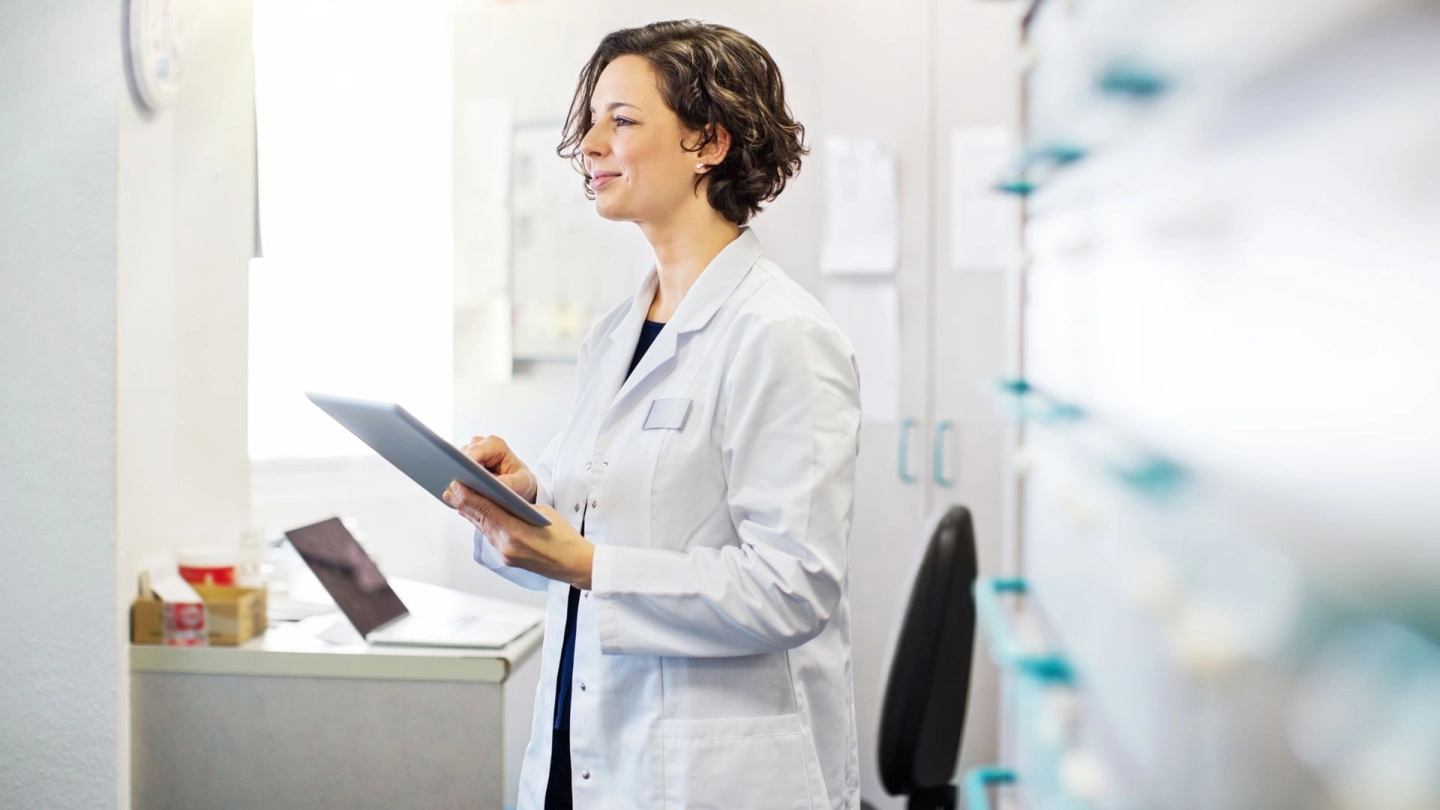Digital health What is telemonitoring?
Health parameters such as blood pressure or heart rate often have to be measured for the correct diagnosis to be made and the course of the disease to be monitored. This usually takes place at a medical practice. However, isolated measurement is not always enough. Telemonitoring enables medical practitioners to also check such parameters remotely and if necessary to act quickly.
At a glance
- Telemonitoring refers to the remote monitoring and evaluation of health parameters.
- Modern telemonitoring measures health parameters electronically and continuously transmits them digitally.
- Telemonitoring can help doctors to treat the chronically ill better.
- Telemonitoring can also be used to prevent an illness and support treatment.

What is telemonitoring?
Telemonitoring refers to the remote monitoring and evaluation of health parameters. These can include blood pressure, blood sugar levels, body temperature and weight and the electrical activity of the brain and heart.
To record such parameters, patients are given, for example, portable measuring devices or apps in which they can enter the parameters they have measured themselves. These health parameters are then transmitted by radio or internet to a telemedicine center, a hospital or a medical practice. The data can be used to enable health developments to be detected quicker and more reliably – by medical practitioners, nursing staff or in an automated manner.
Telemonitoring can mean greater safety for patients with chronic illnesses. Any deterioration in their health can be detected early on. This enables the treatment to be continuously adapted to patients’ individual needs. It is also possible to obtain a clearer picture of how treatment is going.
Telemonitoring can not only be used to constantly keep an eye on the health parameters of sick people. Telemonitoring can also be used for prevention and for aftercare.
How does telemonitoring work?
Telemonitoring involves the use of a range of different resources. Most of the time technical devices are used. The most advanced type is online monitoring where the desired parameters are measured by electronic sensors and continuously transmitted digitally.
These medical sensors can, for example, measure and digitally record blood pressure, heart rate, the electrical activity of the brain (EEG), the electrical activity of the heart (ECG), blood oxygen saturation, lung function, intraocular pressure and many other parameters. As this data is digitally available, it can be easily transmitted to medical practices, hospitals or telemedicine centers.
Apps and other programs are also able to continuously evaluate this information and provide information automatically – for example when life-threatening developments emerge.
The values can also be integrated into digital health applications (DiGA) or, in the future, electronic patient records. This can even be done automatically if the patients so wish. The parameters are then reliably transmitted to the doctors even without the patient having to do anything.
How is telemonitoring used in the chronically ill?
Possible areas of application for the chronically ill can include the treatment of arrhythmias, high blood pressure, asthma, type 1 diabetes and type 2 diabetes.
Telemonitoring can be particularly helpful for patients with chronic heart failure (cardiac insufficiency). In the event of cardiac insufficiency, the cost of telemonitoring is covered by statutory health insurance providers as long as the prerequisites with regard to the severity of the condition are met. If parameters such as weight, blood pressure and heart rate are checked remotely, doctors always have up-to-date information to take appropriate action. This enables them to modify medication doses to the patient’s current health condition.
Telemonitoring can also offer treatment benefits and enhanced safety for people who have been fitted with a defibrillator due to cardiac arrhythmia. It enables potential emergencies to be detected automatically and at an early stage.
Diabetics can keep an electronic diabetes diary and use it to document blood sugar levels, insulin doses injected and carbohydrates consumed. The doctor receives this information automatically via the app or email. This data can be used to modify the insulin dose. This makes it possible, for example, to reduce the blood sugar level with long-term effect.
Telemonitoring can also make everyday life considerably easier for the chronically ill as the number of visits to a medical practice for check-ups can be reduced.
Preventing illnesses and supporting aftercare with telemonitoring
Telemonitoring can also help to prevent illnesses or counteract the progression of a disease. One area of use is impending or existing obesity (being severely overweight). For example, when trying to lose weight it can help to document the body weight, diet and daily activities through the use of portable devices. The data transmitted is evaluated by specially trained medical personnel. The specialists provide personalized and motivational feedback messages.
Information collected and transmitted preventively can also help doctors to better understand diseases that occur later.
During aftercare, telemonitoring can be used to monitor the course of the illness and the success of the recovery process. This enables doctors to promptly adapt measures and medication to current developments, even between in-person aftercare appointments.
- Bundesinstitut für Arzneimittel und Medizinprodukte. Für DiGA-Nutzende. Aufgerufen am 04.12.2024.
- Deutsches Ärzteblatt. Telemonitoring: Digitaler Lebensretter. Aufgerufen am 10.06.2024.
- Luley, C. (2017). Active Body Control (ABC)-Programm – Gewichtsreduktion durch Telemonitoring und Telecoaching. Adipositas - Ursachen, Folgeerkrankungen 2016; 10(01): 31-37
- Kassenärztliche Bundesvereinigung (KBV). Telemonitoring für Patienten mit Herzinsuffizienz startet. Aufgerufen am 10.06.2024.
- Koehler, F., Koehler, K., Deckwart, O., et al. (2018). Efficacy of telemedical interventional management in patients with heart failure (TIM-HF2): a randomised, controlled, parallel-group, unmasked trial. Lancet, 392(10152), 1047–1057.
- Pulickal, T., Helms, T. M., & Perings, C. A. (2021). Der Wearable Kardioverter-Defibrillator als Diagnostikum: Fallbeispiel aus dem telemedizinischen Alltag. Herzschrittmachertherapie & Elektrophysiologie, 32(2), 264–268.
- Wijers, A., Hochstenbach, L., & Tissingh, G. (2021). Telemonitoring via Questionnaires Reduces Outpatient Healthcare Consumption in Parkinson's Disease. Movement disorders clinical practice, 8(7), 1075–1082.
- Zhu, X., Williams, M., Finuf, K., et al. (2022). Home Telemonitoring of Patients With Type 2 Diabetes: A Meta-Analysis and Systematic Review. Diabetes spectrum: a publication of the American Diabetes Association, 35(1), 118–128.
As at:






